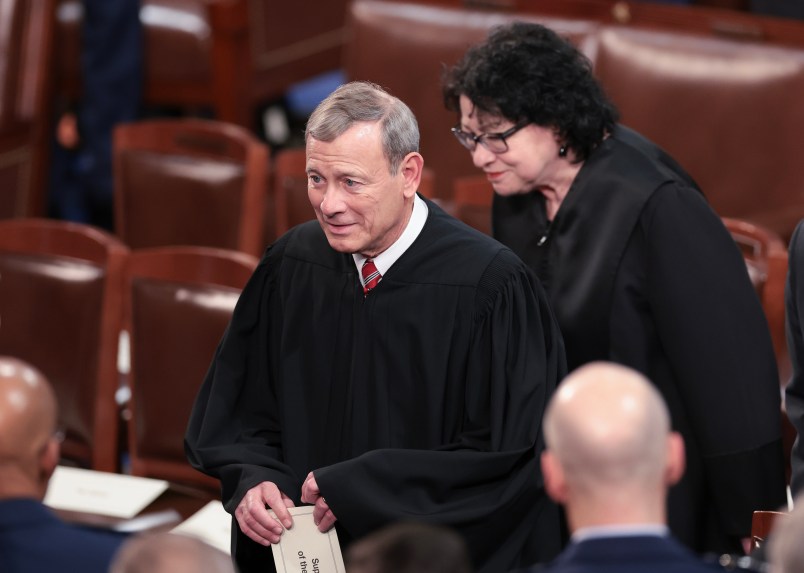Even some of the right-wing justices hitched up an eyebrow Monday when a couple of red states argued against nearly any government intervention in social media content moderation.
The case stems from Biden administration officials sometimes heatedly — to the pearl-clutching shock of Justice Samuel Alito — flagging misinformation to the social media platforms and urging them to crack down on it. Much of the communication centered on anti-vaxxer content at the height of the COVID-19 pandemic.
Traveling a friendly and familiar gauntlet, the respondents — Missouri, Louisiana and a few individuals, whose standing was questioned heavily Monday — arrived at the Supreme Court via a win from U.S. District Judge Terry Doughty of Louisiana, a Trump appointee, and then another from the uber-conservative Fifth Circuit Court of Appeals.
Still, justices from both ideological ends of the bench balked Monday at the extent of free speech rights the red states demanded.
Justice Ketanji Brown Jackson raised a hypothetical where kids are participating in a social media trend by jumping out of windows at increasing heights, injuring and even killing themselves.
“The moment that the government tries to use its ability as the government and its stature as the government to pressure them to take it down, that is when you’re interfering with third-party speech rights,” Louisiana Solicitor General Benjamin Aguiñaga (R) replied, referring to the people who promulgated the hypothetical trend with their posts.
An incredulous Chief Justice John Roberts interrupted.
“Under my colleague’s hypothetical it was not necessarily to eliminate viewpoints, it was to eliminate instructions about how to engage in some game that is seriously harming children around the country, and they say ‘we encourage you to stop that’ — that violates the Constitution?” he asked.
Other justices, particularly Justice Sonia Sotomayor, took issue with the wobbly standing of the respondents in the case, finding it very difficult to track various instances of accounts or posts being blocked with direct government action, rather than the enforcement choices of the platforms themselves.
As part of this argument, she also underscored that the red states seemed to actually fudge the facts at points.
“I have such a problem with your brief,” Sotomayor said to Aguiñaga, ultimately prompting him to apologize. “You omit information that changes the context of some of your claims. You attribute things to people who it didn’t happen to — at least [for] one of the defendants, it was her brother that something happened to, not her.”
The justices who are the natural allies of the red states tried to build on that muddying of the waters, portraying government behavior in the case read as frightening and coercive, rather than commonplace, with the urgency of the language born out of the danger of the moment.
“I see that the White House and federal officials are repeatedly saying that Facebook and the federal government should be partners, ‘we’re on the same team,’ officials are demanding answers — ‘I want an answer, I want it right away’ — when they’re unhappy they curse them out, there are regular meetings, there is constant pestering of Facebook and some of the other platforms,” Alito complained, adding: “I cannot imagine federal officials taking that approach to the print media.”
His rebuttal came in an unlikely form, as Justices Elena Kagan and Brett Kavanaugh — both of whom worked in the White House earlier in their careers — rolled their eyes at the tone policing, saying that this kind of communication between government officials and reporters happens all the time.
“Like Justice Kavanaugh, I’ve had some experience encouraging press to suppress their own speech,” Kagan said, prompting Kavanaugh to laugh. “‘You just wrote a bad editorial, here are five reasons you shouldn’t write another one. You just wrote a story that’s filled with factual errors, here are the 10 reasons you shouldn’t do that again.’ This happens literally thousands of times a day in the federal government.”
The case is a banner example of the culture war content increasingly filling the high court’s docket, helped along by (often Trump-appointed) lower judges’ willingness to grant sweeping relief far beyond what the plaintiffs seek.
In this case, as Justice Neil Gorsuch — a known hater of the practice — pointed out Monday, the trial court enjoined action by platforms the respondents didn’t use, and enjoined actions by nonparties to the case.
“We’ve seen an epidemic of these lately,” he said.
Last week, the Judicial Conference rolled out an announcement and subsequent policy to crack down on this practice, requiring randomization of case assignments seeking nationwide relief from federal or state actions. If enforced well, it’s the kind of reform that can clog up the pipeline that propelled this case from perpetual right-wing whining about “shadow banning” and supposed “censorship” to the space-limited docket of the Supreme Court.







Perhaps they read the words…“radicalized on the internet”…then killed.
Real cat. Jaguar tracks in the Amazon.
The whackadoodles keep pushing the envelope toward their extreme interpretations of the Constitution, but their supposed rights to do that belong only to them. They insist that there are no allowable restrictions on guns, but the government can put as many restrictions on (the other guy) voting as they can do as long as they get their preferred winner.
That’s a nice, simple, clear, accurate recap of the situation.
Cats
And there were the flat-out lies in the arguments accepted by the Fifth Circuit…
Having Kavanaugh slap Alito’s comment down like that pretty much ensures that the entire case is as dead as dead can be. Perhaps Thomas will dissent, but I suspect none of the eight others will see any merit in this case whatsoever after today.